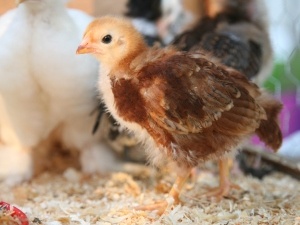
Chicks are very vulnerable because of their small size and weak immune systems. You’d need to keep a close eye on these little birds to ensure that they do eventually reach adulthood.
This article looks at the common leg problems that chicks can develop
Table of Contents
Chick leg problems:
Chicks can develop leg problems because of a number of reasons, these animals can develop leg problems because they lack the right nutrients in their diet, because they were held for too long, or because of an injury:
Soft bones and lameness:
A chick ingesting all the nutrients that it needs will grow normally and in a healthy way. Many of the leg problems that your baby chick will suffer from develop because the bird is not getting enough nutrients.
If your baby chick is lacking in vitamin D3 then the bird will develop soft bones and lameness.
What to do:
If your bird lacks vitamin D3 then you’d need to take a closer look at what your bird is eating.
Make sure that you’re feeding the bird the correct starter and grower feed for its age, breed, and weight. This feed contains the correct levels of D3 for the bird
Straddle legs, curly toe paralysis:
A lack of riboflavin in your baby chick’s diet can be detrimental to the bird for a variety of reasons, a lack of this vitamin will cause the bird to develop curly toe paralysis, straddle legs, and will cause the bird to sit on its hocks.
Straddle legs can also develop when a baby chick is placed on slick flooring after hatching. The bird will lose its footing on the slick floor and the legs will twist out from the hip, the bird’s legs will remain in that position unless you fix them
What to do:
Giving the bird the correct starter and grower feed will ensure that all the riboflavin that the baby bird needs is delivered to them.
Straddle legs can be treated by wrapping a firm material, like a band-aid, around the chick’s legs to get the bird to stand straight thus keeping the bird’s legs in the correct position.
Try to make the surface that the birds are walking on less slippery, or, place white paper towels where the birds walk on. Unfortunately, not all birds will recover from straddle leg.
Perosis
Perosis is a condition that can develop in chicks that are lacking in a nutrient called choline. This ailment is normally seen in younger chicks, chicks that are under 6 weeks of age.
Choline is needed to form cartilage in the bird’s body, cartilage keeps the ankle joint stable. If a baby bird does not have enough cartilage in its body then the bird will develop a twisted leg.
What to do:
Make sure that you give your chick the right feed for their age and weight, namely a starter and a grower feed, this feed will supply the bird with all the nutrients that it needs.
These feeds are designed to have the correct amount of choline for the growing bird.
Crippled chicks:
Chicks can become crippled through an injury or, a baby bird can become crippled while in the egg. If the baby bird comes out of the egg crippled then the bird was likely stored for longer than 10 days prior to being placed in the incubator
What to do:
If a bird comes out of its egg crippled, because it was stored for too long before it was placed in the incubator, then there is nothing you can do except to take care of the crippled baby bird as best as you can.
To avoid this from happening in future, you’d need to make sure that you only store the eggs for 3-7 days prior to placing them in the incubator.
Do not store the eggs for longer than 10 days, 10 days should be the longest that the eggs are stored. Storing them for this long will keep the chances of hatching weak or crippled chickens at a minimum.
Injuries:
Because baby chicks are so small and fragile these little animals can easily become injured by children, other pets, other chicks, or even themselves.
If baby birds are playing with other pets, children, or each other they may over-exert themselves, become scared, and suffer injuries such as lameness, pulled muscles, or slipped joints running out of fear. They may also be accidentally stepped on.
What to do:
If the bird is bleeding, stop the bleeding using a clean gauze or paper towel applying pressure to the area until the bleeding stops. Isolate the injured chick while it recovers, this will keep other chicks from pecking it and force it to relax.
Clean any wounds thoroughly with vetericyn wound care spray or chlorhexidine 2% solution spray and close the wound up.
Adding a vitamin/electrolyte supplement to the bird’s water for a day or two will help with the shock that comes with being injured
If you enjoyed this article then you may also be interested in other chicken related articles. Here are some articles that you may be interested in: Chicken Sprained Leg, Chicken Falling Over To One Side, Crippled Chicken, Paralysis In Chickens Caused By Argas

